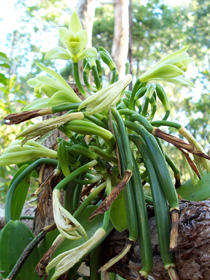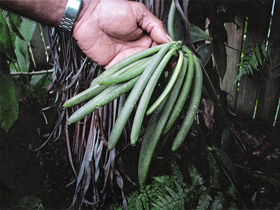Botany
Vanilla is a tropical climbing orchid with the only edible fruit of the orchid family. It is a fleshy, herbaceous vine that grows to a height of 10 – 15 metres, supporting itself on the host plant with aerial roots which are produced all along the stem. Leaves are flat and fleshy and vary in size along the stem.
vine that grows to a height of 10 – 15 metres, supporting itself on the host plant with aerial roots which are produced all along the stem. Leaves are flat and fleshy and vary in size along the stem.
Vanilla is best grown at sea level to 600 metres and the crop thrives in hot, moist, insular climates with frequent, but not excessive rain.
Vanilla is one of the world’s most labour intensive crops. From pollination to harvest, to curing, vanilla is cultivated today as it was centuries ago, entirely by hand.
The orchid flowers once a year over a period of approximately two months with large fragrant and waxy flowers. They usually open in the early morning and are receptive to pollination for about 4 hours. A single plant can produce any number of flowers; however a single flower can produce only one bean.
The beans are harvested by hand when they are green. If they are picked too soon, the vanillin content and quality of the bean will be lower. If they are left on the vine too long, they will become over-ripe and split on the vine.
Different curing methods are used around the world, but the ultimate goal is to produce dark brown, blemish free, oily and supple, good quality beans.
Harvesting and processing techniques are usually something handed down through generations of farmers. If they are not taught or done properly, the quality of the end product is compromised.
Types of Vanilla

There are about 150 varieties of vanilla, though only three types – commonly known as Bourbon, Tahitian and Pompona – are used commercially.
The botanical names of each of these are:- Vanilla Planifolia
-
Native to Mexico and produced in much less quantity there now but marketed as the vanilla from the land of its origin.
Also describes the vanilla from plants introduced to the Indian Ocean Islands such as Madagascar, the Comoros and Reunion; commonly known as Bourbon Vanilla.
- Vanilla Tahitiensis
-
The name of vanilla from French Polynesia, commonly known as Tahitian Vanilla.
- Vanilla Pompona Schiede
-
Is grown in the Antilles and Guadeloupe in the Caribbean. The beans are considered to be of lesser quality as they are smaller, with lower vanillin content than Planifolia or Tahitian.
Vanilla Planifolia, the species grown by Daintree Vanilla & Spice, has the familiar vanilla flavour that we have come to savour in desserts and in ice cream.
Real Vs. Imitation Vanilla
Pure vanilla, whether it be a vanilla bean or pure extract, has a wonderful aromatic flavour that does not compare to any other spice or flavour on the market, though chemists do try to come close with imitation vanilla and vanilla flavouring.
Vanillin is the organic compound flavour that forms that primary component of vanilla bean extract. Vanilla extract is produced by steeping the vanilla beans in an alcohol and water solution for several months, sometimes with sugar added, thereby producing a clear dark liquid with a rich flavour full of aroma.
Imitation vanilla is made with synthetic vanillin – either from the petrochemical guaiacol or from lignin, a natural constituent of wood; and treated with chemicals. It often has a harsh quality that leaves a bitter aftertaste.
Vanilla flavouring is usually a combination of imitation vanilla and pure vanilla extract.
Twice as much imitation vanilla is required to match the strength of pure vanilla extract or the seeds from a vanilla bean.
Though much cheaper, synthetic vanillas today do not come close to competing with pure vanilla – the real thing!
Storage
It is important to store your vanilla beans correctly, so that the quality and flavour of the vanilla bean is not affected.
| Do | Don't |
| store in a cool, dry place in an airtight container | refrigerate, as this can cause the beans to harden and crystalise |
| wrap in oiled paper or wax paper before placing in airtight container, though not necessary | wrap in plastic as this will cause the bean to sweat or grow mildew |
If stored correctly, your beans will have an indefinite shelf life.
Whole beans that have been used in sauces or other liquids can be rinsed, dried and stored for reuse.
Dry or withered beans can also be rehydrated and stored for reuse. Though the vanillin content in the beans may now be lower.
Uses of Vanilla
- There are three main commercial preparations of natural vanilla
-
- Whole pod / bean
- Powder
- Extract / Essences
Vanilla flavouring in food may be achieved by adding extract or powder, or by cooking vanilla pods in a liquid preparation, and then scraping out the seeds from the middle of the pod to further enhance flavour.
The dairy industry uses the largest percentage of the world’s vanilla in ice creams, yoghurt and other flavoured dairy products. Vanilla remains the most popular flavour of ice cream. As well as the food & beverage industry, the cosmetic industry uses it in perfumes and oils.
It can also be used to flavour medicines and applied as a fragrance to conceal the strong smell of different industrial items such as rubber and paint.
- Popular products containing vanilla
-
- ice cream
- cheesecake
- yoghurt
- perfume
- aromatherapy
- candles
- cough mixtures & other medicines
- rubber tyres
- moisturiser
- soft drinks
- shampoo & conditioner
- soaps
- pancakes
- custard
- cakes & desserts
- biscuits
- lip balms
- cigars
- pipe tobacco
- pastries
- coffee & tea
- the list goes on...